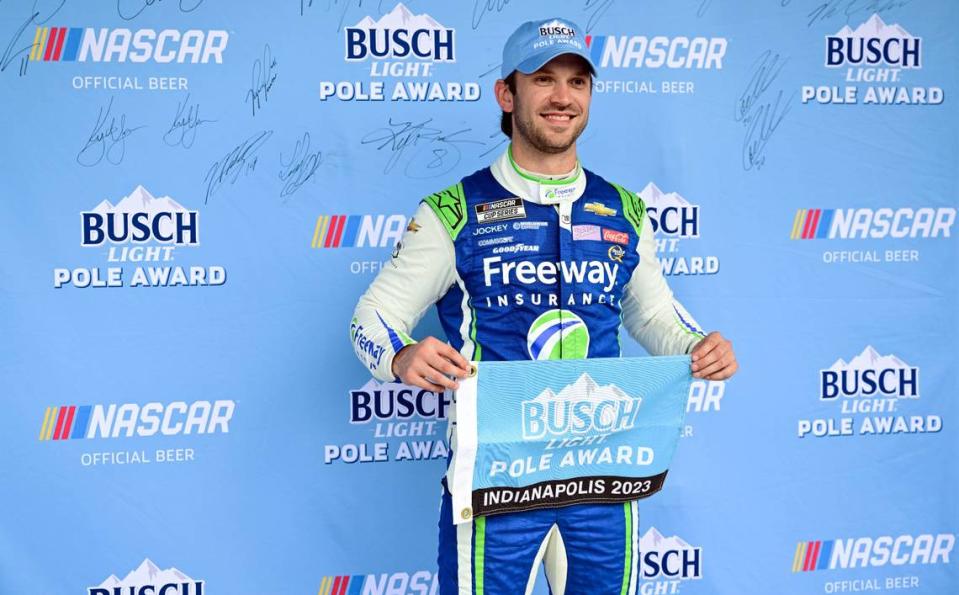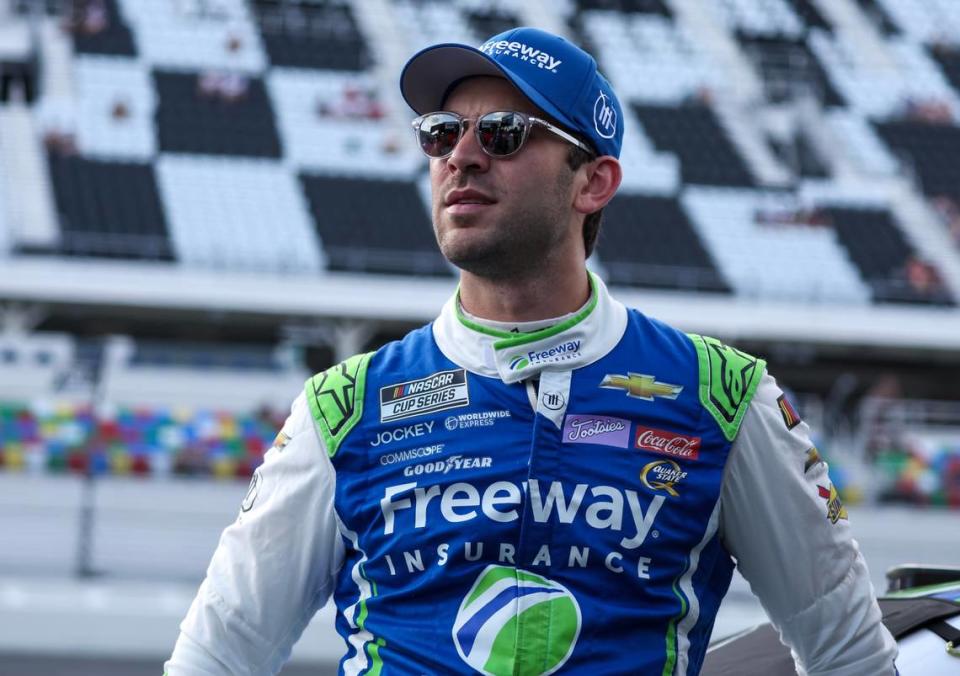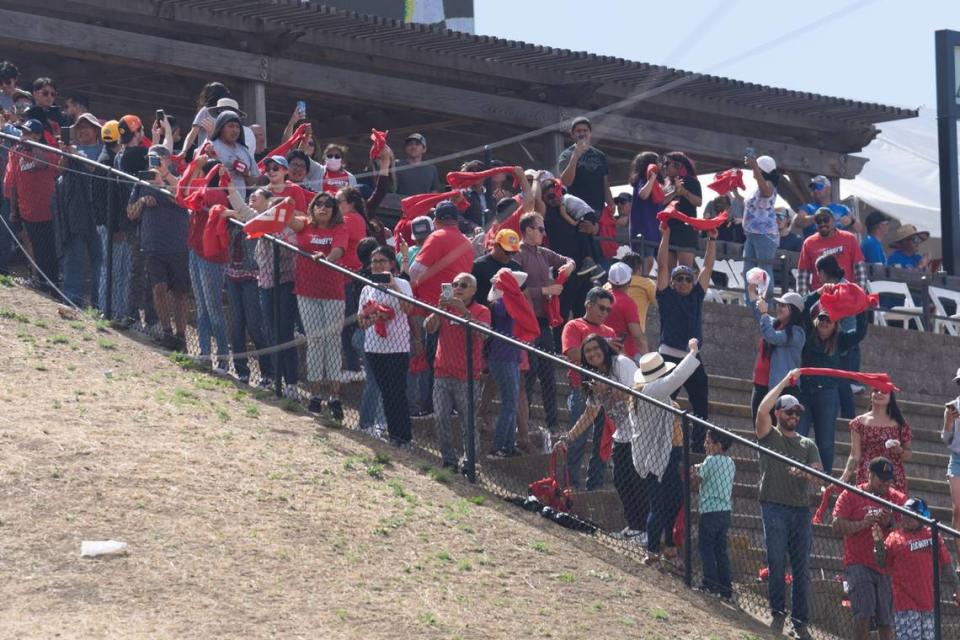From Mexico to Huntersville: Daniel Suarez reflects on journey to NASCAR Cup Series
One Saturday in Monterrey, Mexico, an 11-year-old Daniel Suarez saw a go-kart attached to a trailer.
It belonged to a customer at his father’s restoration shop, and prompted a young Suarez to become enamored with cars. When that customer’s son was unable to race at a nearby track one week, Suarez was invited to fill the open spot. He loved it, and with help from that customer, convinced his father to support his racing interests.
Sitting in his motorhome at Talladega Superspeedway on Saturday, Suarez, the first foreign-born driver to win a NASCAR series title, recalled the moment he felt an epiphany that racing could turn from a hobby to a living. At age 13, his father, Alejandro Suarez, posed him a simple question: Do you want to be a professional race car driver?
“I told him that I already was a professional race car driver,” Suarez explained. “I didn’t really know what he meant. I was so young.
“And then he actually told me: If you work hard, you are disciplined and you are good, you can do this for a living. You can do this as your job. And honestly, that day really changed my life, because since that day, I’ve had in my mind that I’ve really wanted to be a professional race car driver.”
Suarez, who has posted 10 top-10 finishes in 31 Cup Series races this year, will have his No. 99 Trackhouse Racing Chevrolet decked out in an “Aguas Frescas” paint scheme for Sunday’s race at the Charlotte Roval. It’s special for him anytime he sees his “Daniel’s Amigos” fans waving Mexican flags at a racetrack. And on Sunday, he hopes his compatriots feel even more at home as they watch him drive that uniquely-designed car during Hispanic Heritage Month.
This beauty is finally hitting the @CLTMotorSpdwy this Sunday... @MinuteMaid x @Daniel_SuarezG pic.twitter.com/5Bqqg2pNGQ
— Coca-Cola Racing (@CocaColaRacing) October 3, 2023
Suarez’s rise to prominence in Mexico
Initially, Suarez’s goal was to race in the NASCAR Mexico Series, which would require the young driver to transition out of driving go-karts. At the time, there was a series called the Volks Sports Series that used Volkswagen Beetles, which he loved, as his dad would often restore them. So, at age 13, he worked with his father and his co-workers at the shop to turn a Beetle into his first race car.
Suarez received early support from sponsors and, “after a lot of sacrifices for my family,” he reached the Mexico Series as an 18-year-old in 2010. He also added an accolade: Suarez was named the series’ top rookie.
A year later, when presented with the opportunity to race in the United States, Suarez was reluctant. His father had sold his restoration business to support Suarez’s racing efforts, and his mother had taken out a loan against her home. Finances were stretched, and he didn’t want to cause additional stress. On top of that, he didn’t speak English, nor did he have friends or family anywhere in the United States.
Besides, Suarez thought, he’d already accomplished his goal. He was stable in the Mexico Series, driving for TelCel Racing, the series’ most successful team, and he was making money doing what he loved.
But his father, Alejandro, knew Daniel couldn’t pass up the opportunity to become the first Mexican driver to race full-time in the United States. With some convincing from his family, Suarez headed north.
“It was like starting over,” Suarez said. “It was a gamble — a big gamble — that most times doesn’t work. But luckily for me, it did.”

Coming to America: ‘I just didn’t have a plan’
Suarez’s first race in the United States was in California, racing for a small team owned by Troy Williams, a former Xfinity Series driver from western New York.
Suarez remembers Williams, who has assisted in NASCAR’s Drive for Diversity program, telling him that if he learned English and how to communicate, he could be a successful driver. Williams even invited Suarez to move into his house.
Suarez returned to Mexico after that race in California, not knowing exactly where Williams’ house was, but assuming he lived wherever NASCAR was based.
In January 2011, Suarez moved to Buffalo, New York — not where NASCAR is based.
He could barely point out Buffalo on a map, he couldn’t speak much English — and he definitely wasn’t ready for the amount of snow in Buffalo.
Suarez remembers watching the Daytona 500 from Williams’ house, where he ended up living for about four months. Trevor Bayne won that year, and seeing a rookie win such a prestigious race motivated Suarez.
“If he can do it, I’m pretty sure I can do it,” Suarez remembers thinking at the time. “That was how I started to realize that NASCAR was not in Buffalo, New York. It was in Charlotte.”
He returned to Mexico for about a month, and even though he was still racing in the Mexico Series, he decided to climb into his 1994 Volkswagen Beetle and drive it some 1,500 miles from Monterrey to Charlotte.
By the second half of 2011, Suarez was living in the Charlotte area, trying to learn English and meet people in the American NASCAR world. He continued competing in the Mexico Series, while living in North Carolina, until 2013.
“I feel like that’s what makes my journey a little bit unique,” Suarez said. “I just didn’t have a plan. I didn’t have any money to go racing. ... It was one of those things where I just had to go with the flow and try to learn as I was going.”
‘The most difficult years of my life’

In addition to struggling with the language difference, Suarez had difficulty acclimating to the style of racing in the United States. He found that even though he had experience racing ovals in Mexico, the style of racing he found in the U.S. was “completely different” from what he’d known, to the point that he felt himself having to re-learn a lot of skills.
“I was a superstar in Mexico, and I came to the U.S. to stroll — big time,” Suarez said. “I literally had to start from zero again. It was tough. 2011, 2012, those were the most difficult years of my life, without a doubt. There were days when I didn’t think I was gonna make it. There were days I didn’t know if I was good enough. But little-by-little, with support from friends from distance and my family, I was able to learn the language.”
Suarez also didn’t have a clear living situation when he initially came to North Carolina. For several months, he lived with friends of friends, bouncing around places in Concord, Huntersville and Mooresville.
“I didn’t have money, I didn’t have the language and I didn’t know people,” Suarez said. “When you put these three things together, it’s pretty tough, and that’s why (2011 and 2012) were very, very difficult years for me.”
Suarez said he competed in occasional races in the United States when he moved to Charlotte, but most of his racing was still being done in Mexico.
Finally, a breakthrough
He found daylight after the 2013 season, when he joined NASCAR’s Drive for Diversity program and finished second in points in the Mexico Series.
Suarez ran in two Xfinity Series races in 2014 — for Joe Gibbs Racing and the now-defunct RAB Racing — before his first full season at that level in 2015. In that season, he finished fifth in points and was named Xfinity Series Rookie of the Year.
And, he kept climbing.
Suarez won the Xfinity Series championship in 2016, and was elevated to the Cup Series in 2017.
Now in his seventh season competing in the Cup Series, Suarez feels those years really built him into the person he is today. But with the initial unfamiliarity with both the language and country in which he was living, he couldn’t overstate how difficult those early years were.
“There were just a lot of obstacles,” Suarez said, “that 99 percent of drivers don’t have.”
Suarez’s impact on NASCAR
Early in his Cup Series career, Suarez worked on getting to know some of the other drivers, like Bubba Wallace, Chase Elliott, Ryan Blaney and Corey LaJoie. He’d be around them a lot, but just didn’t feel comfortable communicating with them.
Thinking about a driver like Wallace, the only Black driver in the Cup Series field, he said the biggest differences between the two Drive for Diversity drivers are that Wallace was a native English speaker and had his family around him in the United States.
“The biggest fuel and the biggest energy that I have used throughout my life and career to move forward is the sacrifices that people have made to give me a shot,” Suarez said. “I came from a very humble family that literally had to gamble a lot for me to have a shot.
“I guarantee you that there is not one driver in this entire field that has had to struggle financially as much as I have. I don’t know the stories of the other ones, but I feel like mine is pretty hard to match.”
Tyler Reddick, a California native who drives for the Michael Jordan-owned 23XI Racing, has noticed growing diversity among younger drivers, something he attributed in part to drivers like Suarez rising through the ranks. Being teammates with Wallace, he has loved hearing stories about younger drivers from different backgrounds gravitating toward the sport.
“When you look at the drivers who put in the effort on and off the track, Daniel really gets after it,” Reddick said. “He really is motivated, really wants it. And that’s something that’s cool to see.”
Suarez has worked with his sponsors to speak to students at local schools, specifically high schools with significant Latino and Hispanic populations.
“Just trying to talk to them and make them understand how I got here and what it took to get here,” Suarez explained. “The pattern can be different at times. I don’t think that many people would have bet on me to be a NASCAR driver as a Mexican 20 years ago. And here we are right now, in 2023.”
A defining moment
No better moment has transpired in Suarez’s racing career than June 12, 2022, when he won his first Cup Series race.
Getting the checkered flag at Sonoma Raceway was a big deal. Suarez knows he’ll probably win more races, but to win in California — the first state in which he’d raced, where he knows a lot of Mexican immigrants live — and seeing several hundred raucous “Daniel Amigo’s” fans cheering him on in their red shirts during the last lap, was priceless.

“I’m in a sport where, 10-15 years ago, nobody thought that there was an opportunity,” Suarez said. “And right now, we are seeing so many different drivers coming from different parts of the country, different countries, engineers, mechanics, pit crews, and that, for me, is so satisfying. I feel like I’ve been a small part in that process.
“It just feels good to be in this position, and be able to move the needle not just on the track, but also off the track.”
Suarez now lives in Huntersville, just outside of Charlotte, and said he feels at home in the area, where he’s now lived for 12 years. He’s also grown to love places like Miami, fascinated by the varying cultures found within American cities. But the Hispanic community in Charlotte, on top of the area’s proximity to the mountains and beach, has Suarez feeling there’s nowhere else he’d rather be.

